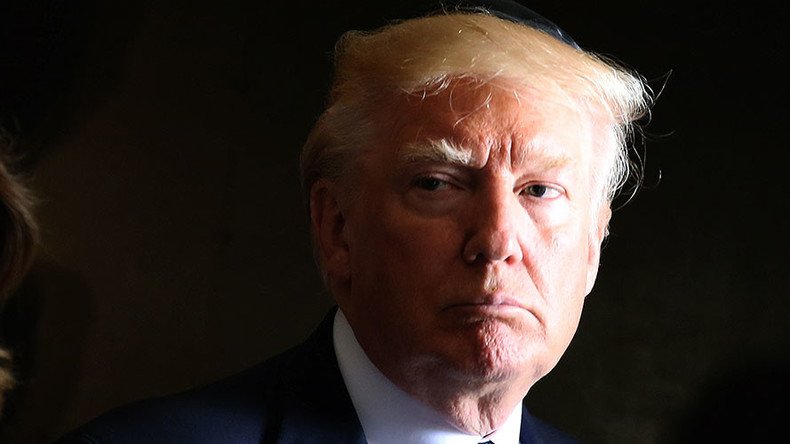Trump’s budget slashes $3.6 trillion from domestic programs over 10 years

The Trump administration's $4.1 billion budget proposal calls for increased spending on law enforcement, the military and the US-Mexico wall, but cuts spending for programs for the poor by slashing funding for Medicaid and cutting food stamps.
“We looked at this budget through the eyes of the one’s paying the bills,” said Office of Management and Budget (OMB) Director Mick Mulvaney told reporters at the White House on Tuesday.
“[F]or years and years we’ve looked at the budget in terms of the people in the back end of the program, the recipients of the taxpayer’s money, and we haven’t spent nearly enough time focusing our attention on the people who pay the taxes. Compassion needs to be on both sides of that equation,” he said.
Under this view, Medicaid, a federal-state health care program for the poor and disabled, would be slashed by more than $600 billion over 10 years. It also envisages capping payments to states and providing more flexibility to manage Medicaid recipients.
Trump's budget is class warfare. pic.twitter.com/j5EwNXyGVl
— DSA 🌹 (@DemSocialists) May 23, 2017
During question time, a reporter asked Mulvaney about Donald Trump's announcement as a candidate that he would “Save Social Security, Medicare, Medicaid without cuts – gotta do it," and whether the Trump was keeping his promises now that he's president.
“We are not kicking anyone off any program who really needs it,” Melvaney responded. “We have plenty of money in this country to take care of everyone who needs help. But not enough for everyone who doesn’t need help.”
Trump is the first president to propose parental leave, Mulvaney said.
The budget outlines a paid parental leave program that accesses a state’s unemployment insurance scheme, but doesn’t include how the federal government will allocate funds to the program or how much. That’s because the states are being asked to figure out how to fund the program, which will probably fall on employers to fund, as unemployment insurance does in most states.
“The proposal will allow states to establish paid parental leave programs in a way that is most appropriate for their workforce and economy. States would be required to provide six weeks of parental leave and the proposal gives it broad latitude to design and finance the program,” stated the budget.
Under the budget plan, $191 billion would be cut from the food stamp program over a decade, representing a 30 percent reduction. The program currently serves 42 million people, a number that hasn’t changed much in a sluggish, recovering economy.
“We need people to work,” Mulvaney told reporters on Monday. “If you are on food stamps, we need you to go to work. If you are on disability and you should not be, we need you to go back to work.”
More than eight in 10 food stamp recipients, or 83 percent, are for households with children, the elderly or a disabled person. The average food stamp benefit is $133.85 a month, or the equivalent of $1.50 a meal. Working people who rely on food stamps are often times using it to supplement their lower income jobs where state and federal minimum wages have not been adjusted to meet living expense increases.
The food stamp program represents just 2 percent of the budget, whereas defense makes up 19 percent.
INTERACTIVE: President Donald Trump's budget https://t.co/tRyE7QhpyFpic.twitter.com/2nnyEey6EY
— AP Politics (@AP_Politics) May 23, 2017
Under the budget proposal, military spending would increase by 10 percent, or an additional $54 billion. It would be financed by cuts to non-defense programs such as medical research and foreign aid.
Law enforcement and border security are also in line for increases.
The budget director coined a new term, "Trumponomics," which he explained was achieving and sustaining 3 percent economic growth, which would represent "a healthy American economy.”
“We have been attacked, stunningly, by some folks on the left and even in the mainstream who say that’s an unreasonable assumption,” Mulvaney complained.
“Ten years ago it was normal. The 1.9 percent growth rates that the previous administration assumed towards the end of their administration… we reject that pessimism.”
Budget watchers like Larry Summers, the treasury secretary under President Bill Clinton, called the budget "simply ludicrous."
@Wonkblog .@realDonaldTrump budget forecasts that US growth will rise to 3.0% -- fair enough if you believe in tooth-fairies & supply-side economics.
— Lawrence H. Summers (@LHSummers) May 23, 2017
Other cuts are planned for federal workers' pensions and higher contributions toward those pension benefits, as well as trimming refundable tax credits paid to the working poor.
Under the proposal, 66 federal programs would be slashed, representing a savings of $26.7 billion. Some of these would receive funding in 2018 as part of a phase-out plan, The Hill reported.
Highway funds for the states could lose $95 billion, while the proposed US-Mexico border wall would get funding.
“We’re absolutely dead serious about the wall,” Mulvaney said.
The Department of Homeland Security would get $44.1 billion, while the Justice Department would receive $27.7 billion for law enforcement, public safety and immigration enforcement programs and activities. The Justice Department will also receive $214 million to hire 75 additional immigration judge teams, bring the total number of funded immigration judge teams to 449.
The proposal calls for investing $2.6 billion in infrastructure and border security technology “including funding to plan, design and construct a physical wall along the southern border.”
Around $300 million will be used to recruit, hire and train 500 new Border Patrol Agents and 1,000 new Immigration and Customs Enforcement law enforcement personnel plus support staff.
An additional $1.5 billion is earmarked for “expanded detention, transportation and removal of illegal immigrations.”
The plan was released while Trump is on his maiden overseas trip as president.
Tucked under the Infrastructure Plan, the budget said the $1 trillion will be met by a combination of “new Federal funding incentivized through non-Federal funding, and expedited projects (like Keystone XL pipeline),” with $200 billion allocated in outlays related to infrastructure initiatives.
The budget falls short on how this will come about, but it later says the Trump administration proposes to privatize US air traffic control. The administration admits that the country has maintained an excellent aviation safety record while operating the world's most congested airspace.
“[T]he proposal to shift the air traffic control function to an independent non-governmental organization beginning in 2021, with a cap reduction in discretionary spending of $72.8 billion, and a reduction in aviation excise taxes of $115.6 billion,” the budget says.
On taxes, Trump promises an overhaul that would cut tax rates to 10 percent, 25 percent and 35 percent, instead of the current rates. The proposal also promises to lower corporate tax rate to 15 percent. There is no detail to prove it would deliver on Trump's promise for "massive" tax cuts.
Democrats' response to the budget were swift, like Senator Ron Widen (D-Oregon) who is the ranking member of the Senate Finance Committee.
This is where the #TrumpBudget belongs. pic.twitter.com/5YtP39OPVx
— Ron Wyden (@RonWyden) May 23, 2017














